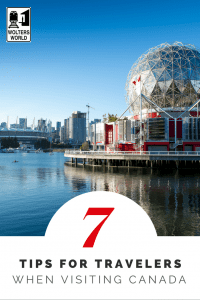What To Know Before You Go: Canada
Greetings from Ottawa, Canada! Today we’re sharing some of the differences, and similarities, between Canada and the U.S. A lot of people around the world assume that Canada and the U.S. are pretty much the same, while others assume the two countries are wildly different. I’ve got some of the differences and similarities that are important for tourists, so you are better prepared for your Canadian vacation.

Language in Canada
In Ontario, English is the official language. However, just next door in Quebec, the official language is French. In Canada, English and French are both official languages. English is widely spoken throughout Canada, while the French language dominates in Quebec. In Quebec, the street signs will be in French, while other parts of Canada may show both English and French, or only English. The closer you get to Quebec, the more French you will see and hear.
Costs in Canada
Canada prices are about 20% more expensive than the U.S., on average. Of course, this will vary by city, and large cities such as Toronto and Montreal will be more expensive, just as U.S. cities like New York and Chicago are more expensive. Just like in the U.S., Canada has a sales tax, which varies by province. Total sales tax in Canada is around 13%. (vs. 9% for the U.S.)
ATM’s are easy to find in Canada. You will pay an ATM fee, but it’s typically slightly less than in the U.S.
The Don’ts of Vancouver
Currency in Canada
Like the U.S., Canada also uses dollars, and the denominations of Canadian dollars are similar to US dollars. Below the $5 bill, you’ll see some differences. In Canada, they have a $2 coin, or a twoonie, and a $1 coin, called the loonie. So, Canadian coins are actually valuable, unlike in the U.S. so keep track of them.
Tipping in Canada
Just like in the U.S., tipping in Canada is expected, and generally in the 15-20% range. Because servers rely on tips, unlike in Europe, you will generally have pretty good service in Canada.

Eating in Canada
Canada has a lot of similar style foods as the U.S. because it’s also a multicultural country. You’ll see a lot of Italian, Chinese and Mexican food in Canada. One difference between the countries is that the U.S. treats itself as a melting pot of cultures, while in Canada the differences in cultures are celebrated, and people are encouraged to maintain their ethnic cultures. Because of this, you’ll find great Chinatown and Little Italy districts in the larger Canadian cities. I highly recommend eating as much poutine as you can while in Canada, as it’s unique to Canada and not found very often in the States.
Driving in Canada
In Canada, speed limits are in kilometers per hour, so beware of the change, especially if you drive from the U.S. into Canada. Drivers in Canada are more slow and easy going. There seems to be less road rage in Canada. The traffic lights are also slightly different than in the U.S. Sometimes you’ll see two red lights, or they may be in different shapes. The biggest difference, though, is the flashing green light, which means only that lane of traffic has the right of way.
In keeping with the metric system, Canada also uses liters instead of gallons. So, when you are purchasing gasoline, the price is displayed in liters. There are 3.75 liters to the gallon, so the gas isn’t as cheap as you might think when you first see the signs.
Electricity in Canada
Canada uses the same voltage and electrical outlet configuration as the U.S. Electronics from the U.S will work in Canada, and vice versa so you won’t need a current converter or outlet adapter when visiting Canada from the U.S.
We love visiting Canada! My kids have a great time, and the people in Canada are super friendly. It feels much safer than many places in the U.S., and Canada has really cool architecture.
Additional Resources for Canada Travelers
Check out some of our other videos about traveling in Canada!
Five Things You’ll Love & Hate About Quebec City
10 Ways Canada and the USA Are The Same
